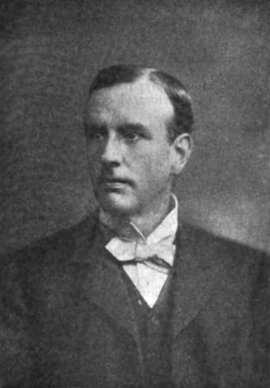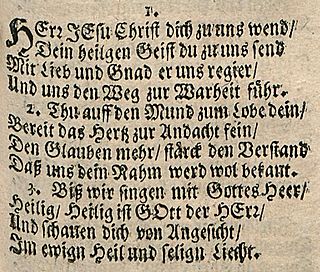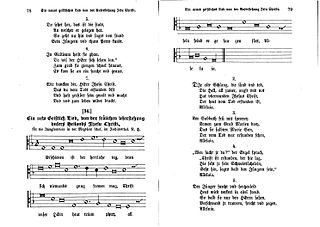Related Research Articles
"Ave verum corpus" is a short Eucharistic chant that has been set to music by many composers. It dates to the 13th century, first recorded in a central Italian Franciscan manuscript. A Reichenau manuscript of the 14th century attributes it to Pope Innocent
"Tantum ergo" is the incipit of the last two verses of Pange lingua, a Medieval Latin hymn generally attributed to St Thomas Aquinas c. 1264, but based by Aquinas upon various earlier fragments. The "Genitori genitoque" and "Procedenti ab utroque" portions are adapted from Adam of Saint Victor's sequence for Pentecost. The hymn's Latin incipit literally translates to "Therefore so great".
Vexilla regis prodeunt is a Latin hymn in long metre by the Christian poet and saint Venantius Fortunatus, Bishop of Poitiers. It takes its title from its incipit.

Gaudete is a sacred Christmas carol, thought to have been composed in the 16th century. It was published in Piae Cantiones, a collection of Finnish/Swedish sacred songs published in 1582. No music is given for the verses, but the standard tune comes from older liturgical books.

Ach Gott, wie manches Herzeleid, BWV 3, is a church cantata by Johann Sebastian Bach. He composed the chorale cantata in Leipzig for the Second Sunday after Epiphany and first performed it on 14 January 1725. It is based on the hymn published by Martin Moller in 1587.
"Verbum supernum prodiens" is a Catholic hymn in long metre by St Thomas Aquinas (1225–1274). It was written for the Hour of Lauds in the Divine Office of Corpus Christi. It is about the institution of the Eucharist by Christ at the Last Supper, and His Passion and death.
"Pie Jesu" is a text from the final couplet of the hymn "Dies irae", and is often included in musical settings of the Requiem Mass as a motet. The phrase means "pious Jesus" in the vocative.

"O come, O come, Emmanuel" is a Christian hymn for Advent, which is also often published in books of Christmas carols. The text was originally written in Latin. It is a metrical paraphrase of the O Antiphons, a series of plainchant antiphons attached to the Magnificat at Vespers over the final days before Christmas. The hymn has its origins over 1,200 years ago in monastic life in the 8th or 9th century. Seven days before Christmas Eve monasteries would sing the “O antiphons” in anticipation of Christmas Eve when the eighth antiphon, “O Virgo virginum” would be sung before and after Mary's canticle, the Magnificat. The Latin metrical form of the hymn was composed as early as the 12th century.

Alan Gray was an English organist and composer.
"What a Friend We Have in Jesus" is a Christian hymn originally written by preacher Joseph M. Scriven as a poem in 1855 to comfort his mother, who was living in Ireland while he was in Canada. Scriven originally published the poem anonymously, and only received full credit for it in the 1880s. The tune to the hymn was composed by Charles Crozat Converse in 1868.

"Ach Gott, wie manches Herzeleid" is a German hymn in 18 stanzas attributed to Martin Moller (1587). It is often catalogued as a paraphrase of the Latin "Jesu dulcis memoria", a medieval hymn attributed to Bernard of Clairvaux, but only a few lines refer directly to this song. Hymn tunes were composed for the hymn, and it is also often sung to a tune composed for "Herr Jesu Christ, meins Lebens Licht". The anonymous hymn tune of "Herr Jesu Christ, meins Lebens Licht" first appeared in Wolflein Lochamer's Lochamer-Liederbuch, printed in Nürnberg around 1455. In Leipzig in the 1720s, Johann Sebastian Bach composed settings of Lochamer's hymn based on four of his church cantatas and a sacred motet.

"Sacris solemniis" is a hymn written by St. Thomas Aquinas (1225–1274) for the feast of Corpus Christi. The strophe of Sacris solemniis that begins with the words "Panis angelicus" has often been set to music separately from the rest of the hymn. It appears about 1768 in the iberian musical form Vilancete/Villancico at Francesc Morera's "Si el grano divino". Most famously, in 1872 César Franck set this strophe for voice (tenor), harp, cello, and organ, and incorporated it into his Messe à trois voix Opus 12. The hymn expresses the doctrine that the bread and wine are changed into the Body and Blood of Christ. In the Roman Catholic tradition the concept of transubstantiation is presented as an explanation of how this change happens.
Die sieben Worte Jesu Christi am Kreuz, SWV 478, is a German-language musical setting of the seven sayings of Jesus on the cross by Heinrich Schütz. It was written in Weissenfels around 1645 and revised in 1657. Schütz set the text of the biblical words in their context, framed by two stanzas from Johann Böschenstein's hymn "Da Jesus an dem Kreuze stund", as an oratorio or Passion cantata. He scored it for five voices (SATTB), five instrumental parts and continuo. The original title reads: Die Sieben Worte unsers lieben Erlösers u. Seeligmachers Jesu Christi, so er am Stamm des Hl. Kreuzes gesprochen.

"Jesu, meine Freude" is a hymn in German, written by Johann Franck in 1650, with a melody, Zahn No. 8032, by Johann Crüger. The song first appeared in Crüger's hymnal Praxis pietatis melica in 1653. The text addresses Jesus as joy and support, versus enemies and the vanity of existence. The poetry is bar form, with irregular lines from 5 to 8 syllables. The melody repeats the first line as the last, framing each of the six stanzas.

"Herr Jesu Christ, dich zu uns wend" is a Lutheran hymn from the 17th century. Its hymn tune, Zahn No. 624, was adopted in several compositions. It was translated into English and is part of modern hymnals, both Protestant and Catholic.

"Erschienen ist der herrlich Tag" is a German Easter hymn, with text and tune written by Nikolaus Herman and published in 1561. It has inspired musical settings by composers from the 17th to the 20th century. It appears in several hymnals, including the German Protestant hymnal Evangelisches Gesangbuch. Other hymns, especially Easter hymns, in both German and English, are sung to the same melody.

"Fröhlich soll mein Herze springen" is a Christian Christmas hymn by Paul Gerhardt, originally in 15 stanzas in artful metre. It was first published, "Frölich sol mein hertze springen", in 1653 in the fifth edition of the hymnal Praxis Pietatis Melica by Johann Crüger, who also created a melody. Johann Sebastian Bach used it as a chorale in his Christmas Oratorio, with a different melody by Johann Georg Ebeling. The song is part, with twelve stanzas, of the current Protestant hymnal Evangelisches Gesangbuch and other songbooks.
Attende, Domine is a Christian liturgical chant for the season of Lent, referred to in English as the Lent Prose. The themes of this hymn are the sinfulness of man and the mercy of God, a theological concept emphasised during Lent. The text is Mozarabic in origin and dates to the 10th century, and is sung to a Mode V Gregorian melody.

"Liebster Jesu, wir sind hier" is a Lutheran hymn with text written by Tobias Clausnitzer in 1663, and a hymn tune, Zahn No. 3498b, based on a 1664 melody by Johann Rudolph Ahle. A prayer for illumination, it is suitable for the opening of a church service and to be sung before a sermon. The song is part of the Protestant hymnal Evangelisches Gesangbuch as EG 161. It is also part of the Catholic hymnal Gotteslob as GL 149. It is popular also in English translations such as "Blessed Jesus, at your word" by Catherine Winkworth.

"O Jesu Christe, wahres Licht" is a Lutheran hymn by the German Baroque poet, Lutheran minister and hymn-writer Johann Heermann. The text was first published in 1630 during the Thirty Years' War. It is a prayer for enlightenment of those who are ignorant, and of those who turned away. It was associated with a melody from Nürnberg, dating to 1676. The hymn is part of modern German hymnals, both Protestant and Catholic. It was translated to English as "O Christ, our true and only light".
References
- ↑ Thesaurus Precum Latinarum
- ↑ ChoralWiki entry for Jesu dulcis memoria
- ↑ 'Dr Alan Gray' in The Times, 30 September, 1935, p. 20
- ↑ ChoralWiki entry for What are these that glow from afar?